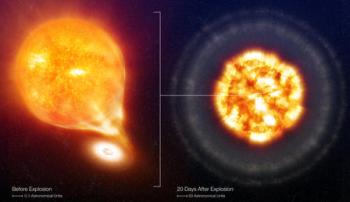Feb 25 2016
Three years after its explosion, a type Ia supernova continues to shine more brightly than expected, new research finds. The observations, made with the Hubble Space Telescope and published today in The Astrophysical Journal, suggest that powerful explosions like this one produce a heavy form of cobalt that gives the heat from nuclear decay an energy boost.
 Artist's rendering of a type 1a supernova before and after explosion. Courtesy of European Southern Obsevratory
Artist's rendering of a type 1a supernova before and after explosion. Courtesy of European Southern Obsevratory
The work could help researchers pinpoint the parents of type Ia supernovae and reveal the mechanics behind these events. These particular types of stellar explosions are frequently used to measure distances to faraway galaxies, and have grown more important to the field in recent decades, after they were used to demonstrate that expansion of the universe is accelerating. But researchers still have many questions about the phenomenon.
“We still do not know exactly what type of star system explodes as a type Ia supernova or how the explosion takes place," said lead author Or Graur, a research associate in the American Museum of Natural History’s Department of Astrophysics and a postdoctoral researcher at New York University. "A lot of research has gone into these two questions, but the answers are still elusive.”
Current research suggests that type Ia supernovae begin in binary star systems, where two stars orbit one another, and where at least one star is a white dwarf. The explosion is the result of a thermonuclear chain reaction, which produces vast quantities of heavy elements. The light that researchers see when a type Ia supernova explodes comes from the radioactive decay of these elements, notably when an isotope of nickel (56Ni) decays into an isotope of cobalt (56Co) and then into a stable isotope of iron (56Fe).
Science Bulletins: Shedding Light on Type Ia Supernovae
This light continues to radiate for years, and though studies predict that about 500 days after an explosion, researchers should see a sharp drop-off in the brightness of these supernovae, no such drop-offs have been observed. This anomaly prompted Ivo Seitenzahl, a researcher at the Australian National University and the ARC Centre of Excellence for All-sky Astrophysics and one of the co-authors on the paper, to predict that the continuing brightness must be due to the radioactive decay of a heavier isotope of cobalt with a longer half-life (57Co).
The researchers tested and confirmed this prediction directly by using the Hubble Space Telescope to observe the type Ia supernova SN 2012cg more than three years after it exploded in the galaxy NGC 4424, which is about 50 million light years away—nearby in astronomical terms.
“We saw the supernova’s brightness evolve just as Ivo predicted,” Graur said. “We now have a new piece in the puzzle that is type Ia supernovae, one of the most important tools in modern cosmology.”
To learn more about type Ia supernovae, check out this video about Graur's work from Science Bulletins: